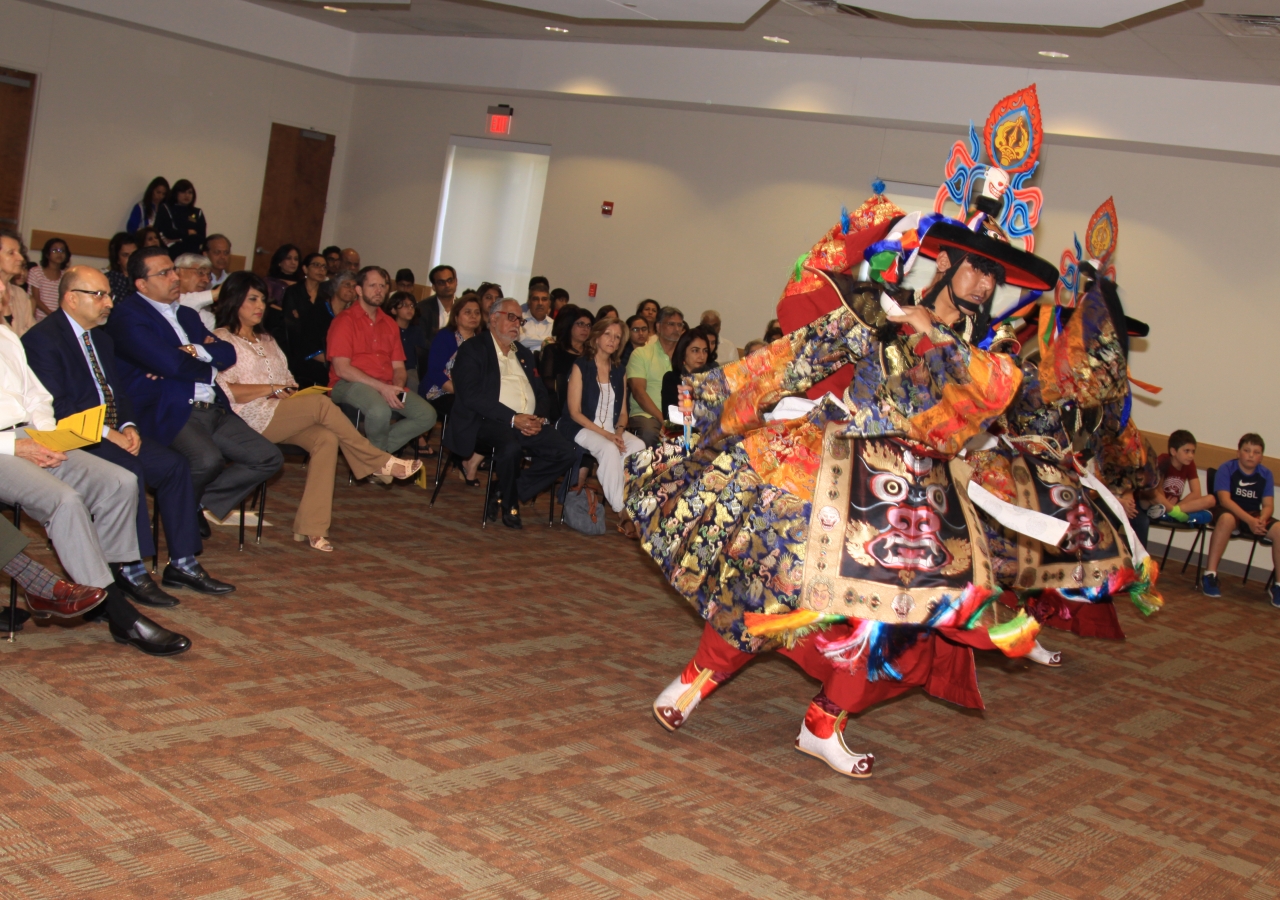A snow lion danced into the social hall of Plano Jamatkhana, an explosion of energy and flailing furry limbs. It quivered and shook, rolled and rollicked, tousling the rainbow tassels which dangled from each plush ear. Finally, its waggling tongue unraveled as if it were a scroll to display two uniting words—“World Peace.”
On Tuesday Aug 15, 2017, Plano Jamatkhana partnered with the Thanks-Giving Foundation and the Crow Collection of Asian Art to host a performance of The Mystical Arts of Tibet: Sacred Music Sacred Dance. Tibetan monks from the Drepung Loseling shared their cultural dances and chants from old texts and scriptures to promote world healing and bring people together.
“Pluralism is all about respecting diversity, of reaching out to understand the other,” Samina Hooda, the Communications Coordinator for the Aga Khan Council for Central United States, said. “It is being confident in your own identity but also being comfortable with understanding the other identities and finding commonalities. In the implementation of this event, we exercised pluralism by partnering with different organizations.”
Annually, the tour comes to the Crow Collection of Asian Art. Because the museum is under construction this year, the tour was scheduled to bypass the DFW Metroplex. But as a result of the persistence and dedication of all parties involved, Plano Jamatkhana received the honor of hosting the event.
“I love that the Ismaili center here and Thanks-Giving Square have helped bring the living traditions of Tibet outside the museum,” Amy Lewis Hofland, the Executive Director of the Crowe Collection of Asian Art, said. “I think the more that we reach communities, the more we reach audiences, the more people learn about this beautiful tradition.”
To Hofland, the most memorable parts of the program involved recitation. During the invocations, the monks showcased the multiphonic chanting, called zokkay, or overtone singing, where they would simultaneously sing three notes to create a complete chord.
“It was a surprise to me how moving sounds and movements I had never heard before were to me,” Chris Slaughter, President and Chief Executive Officer of the Thanks-Giving Foundation, said. “Even though I could not understand the words, there was a lot of communicating going on that I felt.”
Other highlights from the performance included the aforementioned Snow Lion Dance, which, according to the event program, symbolized “the fearless and elegant quality of the enlightened mind” as well as the debate, which was a compelling demonstration of monastic inquiry. In the latter, the monks delved deeper into subjects of debate with passion, the Challenger and Defender gesturing and clapping to mark the progress of the discussion. The right hand represents method while the left represents wisdom; clapping signifies the joining of the two.
“Everything has value,” Samina said. “Their dance moves, their actions, whatever they expressed. Everything has symbolism behind it. It tells people that culture has many facets and if you really scratch the surface you will get to know more about a community rather than just knowing them at a surface level.”
Since the 1980s, the tour for Sacred Music, Sacred Dance has sought to preserve the rich history and practices of Tibet. Each monk takes 17 years to complete their monastery education and receive the title of ‘Geshe.” To perform as part of the tour, a monk must be selected by elders within the monastery and train for at least an entire year.
“Some people question the appropriateness of bringing these sacred ancient arts to the West and performing them outside the ‘sacred’ environment,” Geshe Lodon, the spokesperson for the monks, said. “To the Tibetans, there is no conflict. The Tibetan Buddhist way of life is that all places are equally sacred. A performance hall becomes a temple when we become aware of the sacredness of the environment.”
After their performance, the monks said the performance gave them the opportunity to spread their culture -- vital to creating one, global community.
“I feel honor and privilege to be here, to share our faith and beliefs here,” Geshe Chodak, a monk in the performance, said through translator Geshe Lodon. “By inviting us and promoting more kinds of interfaith, that is how we can understand each other.”











